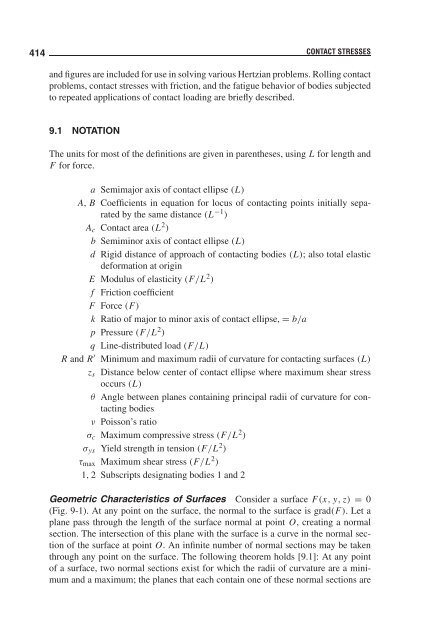9 Contact Stresses
9 Contact Stresses
9 Contact Stresses
You also want an ePaper? Increase the reach of your titles
YUMPU automatically turns print PDFs into web optimized ePapers that Google loves.
414<br />
CONTACT STRESSES<br />
and figures are included for use in solving various Hertzian problems. Rolling contact<br />
problems, contact stresses with friction, and the fatigue behavior of bodies subjected<br />
to repeated applications of contact loading are briefly described.<br />
9.1 NOTATION<br />
The units for most of the definitions are given in parentheses, using L for length and<br />
F for force.<br />
a Semimajor axis of contact ellipse (L)<br />
A, B Coefficients in equation for locus of contacting points initially separated<br />
by the same distance (L −1 )<br />
Ac <strong>Contact</strong> area (L 2 )<br />
b Semiminor axis of contact ellipse (L)<br />
d Rigid distance of approach of contacting bodies (L); also total elastic<br />
deformation at origin<br />
E Modulus of elasticity (F/L 2 )<br />
f Friction coefficient<br />
F Force (F)<br />
k Ratio of major to minor axis of contact ellipse, = b/a<br />
p Pressure (F/L 2 )<br />
q Line-distributed load (F/L)<br />
R and R ′ Minimum and maximum radii of curvature for contacting surfaces (L)<br />
zs Distance below center of contact ellipse where maximum shear stress<br />
occurs (L)<br />
θ Angle between planes containing principal radii of curvature for contacting<br />
bodies<br />
ν Poisson’s ratio<br />
σc Maximum compressive stress (F/L 2 )<br />
σys Yield strength in tension (F/L 2 )<br />
τmax Maximum shear stress (F/L 2 )<br />
1, 2 Subscripts designating bodies 1 and 2<br />
Geometric Characteristics of Surfaces Consider a surface F(x, y, z) = 0<br />
(Fig. 9-1). At any point on the surface, the normal to the surface is grad(F). Leta<br />
plane pass through the length of the surface normal at point O, creating a normal<br />
section. The intersection of this plane with the surface is a curve in the normal section<br />
of the surface at point O. An infinite number of normal sections may be taken<br />
through any point on the surface. The following theorem holds [9.1]: At any point<br />
of a surface, two normal sections exist for which the radii of curvature are a minimum<br />
and a maximum; the planes that each contain one of these normal sections are
















